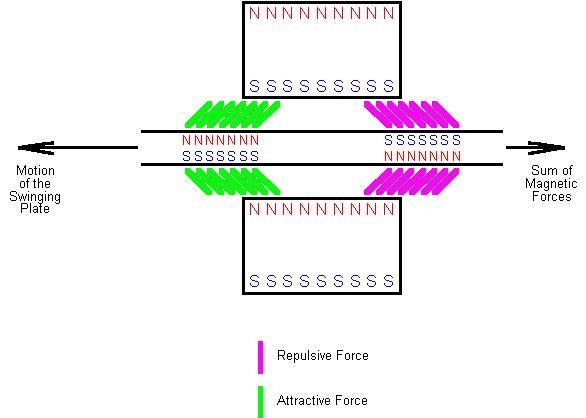



Experiments with magnets and conductors
Pendulum
Description:
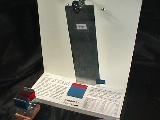
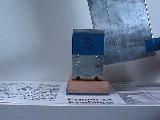

The pendulum experiment
demonstrates how Eddy currents in a conductor, created by the
relative motion between a magnet and the conductor (see Faraday's Law of Induction and Lenz's
Law), will resist the
motion of the pendulum. I wanted to see how well this works
with different types of material and different thickness of the
same material.
Construction: ![]()
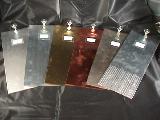
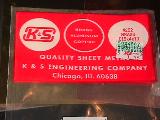
I was able to buy different types
and thickness of metal like copper, aluminum and brass, in the
hardware store. They came cut in 4" by 10" pieces.
I found a piece of stainless steel in my father's garage, and
used a piece of silver which was purchased from a jewelry making
supply store. I also found a zinc plate from a surplus
supply store. I labeled each sample with the material and its
thickness.
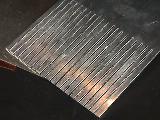
I also took an aluminum plate and
cut several vertical slots in it, as shown here, to see what
effect this had on the experiment. The slots were about 0.10"
apart, and were about 2.5" deep. The widths of the
slots were just the width of a hacksaw blade, about 1/32"
thick.
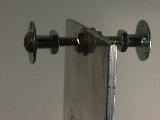
I made the hinge out of a 2"
10x32 screw, two tee-nuts, two washers and four nuts. This
was attached to each metal pendulum. The holes in the tee-nuts
were lined up on top before the nuts were tightened.

The stationary part of the hinge
is attached to the wooden back, and uses a 4" 1/4x20 screw,
two tee-nuts, and two nuts. It is secured to the back with
a nut and washer. The holes in these tee-nuts were lined up
on the bottom.

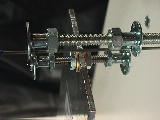
A piece of 0.067" music wire
as a pin is used to connect the two pieces of the hinge together
with very low friction. The pin went through the front
bottom hole of the larger tee-nut, through the front top hole
of the smaller tee-nut on the pendulum, then through the back
top hole of the tee-nut on the pendulum, and finally through the
back bottom hole of the larger tee-nut. This lets the
pendulum swing freely. It also allows you to easily replace
the pendulum with a different one.
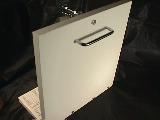
The back and base of the stand are
made of pressboard shelving, 11 3/4" wide, with a white
laminate surface. Its dimensions are about 6" deep, 12
3/4" high and 11 3/4" wide. I added a 4"
handle to the back to easily carry it around. Using this
material was easy to work with since it had a nice finish to its
surface. Some of the edges were also finished, but the
others were kept bare after it was sawn.
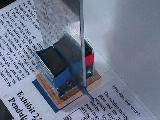
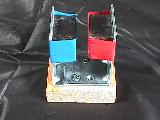
The magnet is made of two Ferrite
magnets attached to two L brackets on a smaller, separate, wooden
base which can be moved. They were taped so if the plate
hit the magnets, they wouldn't chip.
Demonstration:
Pull the pendulum plate to the side to a prescribed angle (For example 25 or 30 degrees from vertical. Mark the back board with a line to indicate this angle.) and let go of it. Use a stop watch to time how long it takes from when you let go of it to when it stops swinging. How quickly does it stop? Remove the magnet and try it again. Does it swing for a longer time? How long?
Try some other pendulums made from different types of materials and/or thickness to see how quickly they stop when they swing between the magnets.
Below is a table of the types
and dimensions of the materials I used for the pendulum
experiment. Please note that all of the materials used are
non-magnetic.
| Material | Thickness, in | Width, in | Height, in | Weight, lb |
| Aluminum | 0.030 | 4 | 10 | 0.12 |
| Aluminum | 0.061 | 4 | 10 | 0.24 |
| Aluminum | 0.119 | 4 | 10 | 0.47 |
| Aluminum with slots | 0.061 | 4 | 10 | 0.23 |
| Brass | 0.016 | 4 | 10 | 0.21 |
| Brass | 0.032 | 4 | 10 | 0.41 |
| Copper | 0.026 | 4 | 10 | 0.34 |
| Copper | 0.125 | 2 | 10 | 0.81 |
| Silver | 0.025 | 4 | 2.5 | 0.09 |
| Stainless Steel | 0.020 | 4 | 9 | 0.20 |
| Zinc | 0.032 | 4 | 2 | 0.07 |
I made a holder out of Plexiglas for the
smaller pieces of material. Ideally, each pendulum would
have the same dimensions.
Experimental Question:
How does the material of a pendulum affect the ability of a magnetic field to stop its swinging?
Hypothesis:
The following criteria should
cause the pendulum to stop swinging sooner:
a. Better conducting material (higher
conductivity)
b. Thicker conductor (lower
resistance)
Method:
I made pendulums out of copper,
aluminum, silver, brass, zinc and stainless steel. All of
these are non-magnetic and have different values for conductivity.
For the aluminum, brass and copper pendulums, I have more than
one thickness to see what effect that would have.
Results:
As noted above, I timed how long
it would take for the pendulum to stop swinging without the
magnet. I started it swinging at an angle of about 25° and
stopped timing it when it would swing back and forth less than 1/8".
Then I put the magnet in the middle and started the pendulum
swinging the same way and timed how long it would take for it to
stop. I then put a different pendulum on and repeated the
experiment. The table below gives the results.
| Material | Thickness, in | Time to stop w/o magnet, sec | Time to stop w/ magnet, sec |
| Aluminum | 0.030 | 102 | 1.33 |
| Aluminum | 0.061 | 281 | 0.94 |
| Aluminum | 0.119 | 1188 | 0.85 |
| Aluminum with slots | 0.061 | 316 | 56.83 |
| Brass | 0.016 | 653 | 6.56 |
| Brass | 0.032 | ? not done yet | ? not done yet |
| Copper | 0.026 | 653 | 1.31 |
| Copper | 0.125 | 888 | 2.40 |
| Silver | 0.025 | 1014 | 1.71 |
| Stainless Steel | 0.020 | 299 | 50.34 |
| Zinc | 0.032 | 706 | 6.51 |
Conclusions:
For the aluminum, the thicker it is, the faster it would stop. This is because the resistance would be lower for the induced voltages, allowing higher induced currents to flow, creating stronger magnetic fields. For the fields created, the force would stop the aluminum sooner than another material because its momentum was less (due to lower density). The aluminum with slots was not affected much because the slots increased the resistance, lowering the induced current. The other materials, like brass, do not conduct as well so the induced current is less and thus take longer to stop. The copper pendulums took longer to stop than the aluminum ones because they have a lot more momentum and require a greater force to stop them swinging compared to the aluminum.
This is a simplified diagram showing the areas of attraction and repulsion in this experiment.
